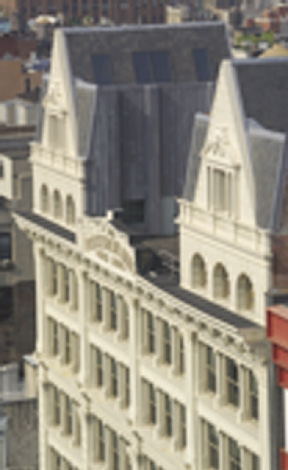November 9, 2007 - Hoffmann Architects, Inc., an architectural and engineering firm specializing in the rehabilitation of building exteriors, received a 2007 AIA Connecticut Design Award for Preservation.
The Design Awards are a means for the Connecticut chapter of the American Institute of Architects (AIA) to recognize "the accomplishments of Connecticut architects and the excellence of Connecticut architectural projects." Hoffmann Architects' façade renovation of the Scholastic Inc. building at 555 Broadway in New York City received an Honorable Mention from the jury because the project is, in their words: "a tribute to what the building was originally, the cast iron façade of the 1888 Rouss Building." The jury notes, "We chose this building because of the technical skill and expertise in the construction and preservation technique." The 555 Broadway building adjoins and is internally connected to the 557 Broadway global headquarters of Scholastic, the global children's publishing, education and media company.
Renovation of the Scholastic building's 1880s cast-iron façade required technical proficiency with historic materials and coatings, as well as sensitivity to the concerns of tenants and shoppers in the commercial and corporate structure. The design team oversaw the stabilization, removal, restoration, and reattachment of deteriorated brick, cast iron, and sheet metal façade elements. Extensive masonry and window restoration, along with a new design scheme for the cast-iron structural system, laid the groundwork for an aesthetic overhaul that returned the building to its turn-of-the-century appearance. Twelve layers of paint were removed from intricate cast iron and tin columns, cornices, and entablatures, and a final color scheme, selected with the owner, recreated the original design.
Under Landmarks Preservation Commission regulations, only original materials could be specified, demanding competence in working with materials no longer in common use, such as cast iron, tin, copper, and slate. Finishes and ornamentation were also closely monitored by the LPC to ensure historical accuracy.
Despite the potential for noise, dust, and debris involved in removing and replacing hundreds of pieces of cast iron and tin, sections of brick, and a dozen layers of paint, rehabilitation was completed with minimal disruption to tenants.
Tags:
Hoffman Architects receives AIA Connecticut Design Award for Preservation
December 07, 2007 - Owners Developers & Managers
 (1).png)








